Heritage Day at Valley Farm in Flatford
Valley Farm is the oldest building on site at Flatford. Built in the mid-15th century, it is a medieval Great Hall House that was home to wealthy yeoman farmers up until the early 1900s. It is a good example of a medieval, open hall house which is now a Grade 1 listed building.
On the 8th September, the National Trust had its Heritage Open Day when many of the properties normally closed to the public, are open for the day - for free. Having walked past Valley Farm many times, we decided to have a look inside.
Unfortunately, only the central hall was open, but was well worth the visit, partly due to the very knowledgeable staff on hand.
At one time Willy Lott's grandparents (English and Mary Lott) lived at Valley Farm and it was later owned by Willy Lott’s brother John (a farmer like his brother) who lived there with his wife and 14 children.
Outside, the walls were timbered and painted with lime wash at regular intervals to preserve the timber frame and seal the gaps between the timbers and the wattle/daub infill - whilst allowing the whole building to breathe.
Valley Farm was called an 'open hall house' because there was no upper floor, the central hall being open up to the roof rafters. Originally the fire in the room would have been laid on the stone floor with the smoke going up to the underside of the roof ridge and escaping through the roof tiles or through a smoke hole in the gable end wall.
Looking up you can see the blackened timbers where the smoke used to rise. Behind you can see the brickwork of the 16th century chimney.
In the sixteenth century a massive inglenook fireplace and chimney were built to replace the open fire and an upper floor was added for use as bedrooms.
In 1901 Leonard Richardson bought Valley Farm. He lived there with his wife and three daughters Kathleen, Sylvia and Margaret and farmed the surrounding land. In the late 1920's he became increasingly anxious about the condition of the house and between 1928 and 1935 wrote repeatedly to the Society for the Protection of Ancient Buildings asking them for help with the cost of repairs - but no financial help was forthcoming.
Leonard Richardson sold Valley Farm in 1935 to the Society for the Protection of Ancient Buildings for £1,500. The Society undertook major repairs and restored the building to its near original state. The upper floor was removed - although the marks on the vertical timbers clearly show where it was. The inglenook fireplace and chimney were retained and can be seen to this day.
In 1959 Valley Farm was acquired by the National Trust with the Field Studies Council as a sitting tenant, but by the early 1970's, Valley Farm was falling into disrepair again. The National Trust undertook a further programme of repairs as advised by the Society for the Protection of Ancient Buildings.
Another great feature was a wonderful oak log stairway to the upper floor at one end of the screens passage. Considering its age, in brilliant condition.
As the windows had no glass in them, I guess the little overhang in the above image (top left), did shelter the residents a little.
To the rear of the building is the restored Valley Farm Kitchen Garden which is maintained by a group of expert garden volunteers.Their produce supplies not only the Tea room but also a barrow next to Bridge Cottage where you can pick some up for a small donation to take home with you.
The restored Kitchen Garden with its Box Hedge. When uncovered, it still had all its paths and edges still visible. Just covered and forgotten under years of neglect.
The rear view of what was the living area originally, with Mulberry trees on the right.











Comments